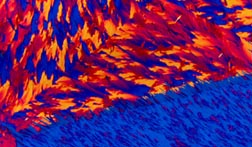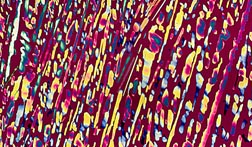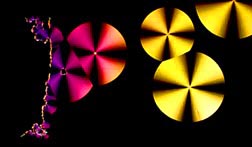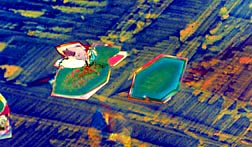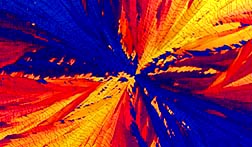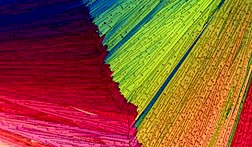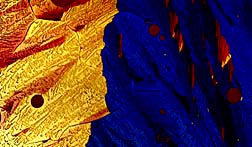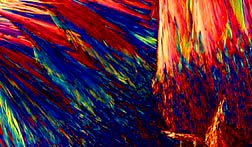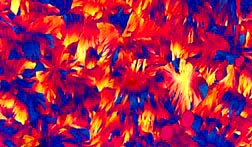Drugs For Bugs
The term pest derives from the Latin pestis for plague and is used to describe plants (mostly weeds), vertebrates, insects, mites, pathogens and other organisms which occur where we do not want them. Large agricultural endeavors have intensified the problem by concentrating a large population of pests in discrete areas.
Dichloran
|
This fungicide is a member of the substituted aromatic class of pesticides derived from the parent compound hexachlorobenzene. These chemicals are useful for seed treatment and in some instances, as a wood preservative. The mechanism of action displayed by this diverse group of pesticides is probably by chemically combining with biological amines and thiols. The fungistatic activity generally results in a reduction of fungi growth rates or interference with sporulation. Dichloran has moderate oral toxicity to animal life and has proven useful in controlling fungal diseases in many fruits, vegetables, ornamental diseases, and field crops. It is particularly effective against the Botrytis, Monilinia, Rhizopus, Sclerotinia, and Sclerotium fungal species. |
With the availability of vast quantities of succulent food and often the absence of natural enemies, pests can reproduce quickly and become a serious agricultural problem. Insects, in particular, often exhibit a dramatic and rapid increase in population size under these conditions. The average soil density of insects is about 9 million per acre with about 10 thousand "in flight" above it.
Monuron
|
This herbicide is a member of the substituted urea class of pesticides, which are relatively nonselective and are usually applied to the soil as pre-emergence herbicides. However, some substituted ureas have post- emergence uses, while others are active when foliar applied. The ureas are readily absorbed by the roots and rapidly translocated to the upper plant segments, producing phytotoxic symptoms that are most visible in the leaves. The primary site for biological activity appears to the Hill photosynthetic reaction, although other mechanisms have been postulated. Monuron has been used for pre-emergence control of broad-leaved and grass weeds to protect crops such as cotton, sugar cane, pineapple, asparagus, and citrus. |
The world's main source of food is plants and the animals that rely on plants for their diet. Among the 800,000 species of insects, about 10,000 are plant-eating and add to the devastating loss of crops throughout the world.
Carbaryl
|
Introduced in 1956, Carbaryl was the first carbamate to be successful in the insecticide industry. In terms of shear bulk, more of this pesticide has been used worldwide than all of the other carbamates combined. Carbaryl has two distinct properties that account for its popularity: it has a very low mammalian oral and dermal toxicity and it possesses a rather broad spectrum of insect control. This has led to its wide-spread household use as a lawn and garden insecticide. Like the other carbamates, Carbaryl antagonizes acetylcholine and competes for binding sites on the enzyme cholinesterase. In agriculture, carbaryl is used as a contact insecticide recommended for use against pests of fruit, vegetables, cotton, and many other crops. |
Equally important are the agricultural crop losses due to weed infestation. Weeds deprive the crops of moisture and nutritive substances from the soil. In some instances they even shade crops and hinder their growth. The use of herbicides in the control of weeds is now a standard practice in the United States, and it has been estimated that we would have 10 to 12 percent of our population working on farms, manually dissecting weeds from the crops, were it not for herbicides.
Paraquat
|
This powerful defoliant is a member of the bipyridylium class of pesticides. The two most important herbicides in this group are paraquat and diquat, both of which are contact herbicides that damage plant tissues quickly, causing the plants to appear frostbitten because of cell membrane destruction. This rapid degeneration occurs within hours of application, making these novel herbicides also useful as preharvest desiccants for seed crops, cotton, soybeans, sugarcane, and sunflowers. Diaquat is sometimes used in aquatic weed control, and paraquat applications include stubble clearing, pasture renovation, inter-row weed control in vegetable crops, and weed control in plantation crops. Paraquat earned a degree of notoriety several years ago when the United States government collaborated with the Mexican government to treat marijuana fields with the defoliant. Many drug users who were exposed to paraquat-laced marijuana developed nosebleeds, headaches, vomiting, and breathing disorders. |
Microorganisms also contribute heavily to argricultural crop destruction. Most plant diseases can be controlled to some extent with modern synthetic fungicides. In general, fungal plant diseases are basically more difficult to control with chemicals than are insects because the fungus is a plant living in close quarters with its host.
DDT
|
This organochlorine insecticide can be considered as the pesticide of the greatest historical significance, due to its effect on the environment, agriculture, and human health. First synthesized by a German graduate student in 1873, it was rediscovered by Dr. Paul Mueller, a Swiss entomologist, in 1939 while searching for a long-lasting insecticide for the clothes moth. DDT subsequently proved to be extremely effective against flies and mosquitoes, ultimately leading to the award of the Nobel Prize in medicine for Dr. Mueller in 1948. Effective January 1, 1973 the Environmental Protection Agency (EPA) officially canceled all uses of DDT, but not before more than 1 billion kilograms of DDT had been introduced into the United States. Like Endosulfan, DDT disrupts the delicate balance of sodium and potassium within neurons. The pesticide is effective against a wide spectrum of insects in the agricultural arena and also mosquitoes that transmit malaria and yellow fever as well as body lice that carry typhus. |
This makes it especially arduous to find chemicals which will selectively destroy the fungus without harming the plant. Other organisms that cause plant diseases are viruses, rickettsias, algae, nematodes, and mycoplasma.
Aldicarb sulfone
|
This very toxic insecticide is the sulfone metabolite of the carbamate aldicarb. Unlike most nematicides, Aldicarb is provided as a granular powder which significantly reduces the handling hazards. Aldicarb is drilled into the soil, a process known as "Spiked", at planting or during various stages of plant growth. The carbamate is then solubilized by ground water and is absorbed by the roots and translocated throughout the plant, killing both insects that pierce and suck foliage as well as nematodes in and around the roots. The plants oxidize the parent aldicarb carbamate to the sulfone derivative during translocation and it is this species which is responsible for the insecticidal properties. Aldicarb is currently registered for cotton, potatoes, sugar beets, oranges, pecans, peanuts, sweet potatoes, and ornamentals. |
Approximately one-third of the world's agricultural food output is destroyed by pests during growth, harvesting, and storage. In the United States alone this amounts to about $20 billion annually despite the heavy use of pesticides and other current control methods. One is tempted to wonder what the losses would be without pesticide use.
Chlordane
|
This well-known insecticide was the first member of the cyclodiene class of pesticides introduced in 1945. Other members of this class include Aldrin, Dieldrin, Heptachlor, Endosulfan, and Chlordecone (Keponer). The cyclodienes are persistent insecticides that are very stable in soil and relatively stable to ultraviolet radiation from sunlight. Subsequently, they have been widely used as soil insecticides and for control of termites and soil-borne insects whose immature stages (larve) feed on the roots of plants. These insecticides are the most effective, long-lasting, economical, and safest termite control agents yet developed. Unfortunately, several soil insects have developed resistance to these chemicals in agriculture, which has resulted in a rapid decline in their use. |
Pesticides are a big business with a lot of money at stake. Annually, United States manufacturers produce almost a billion kilograms of synthetic organic pesticides, valued at over $5 billion, with an even higher retail value.
DCPA
|
Chlorthal is the common name given to this arylaliphatic acid by the International Standards Organization, but the herbicide was renamed DCPA by the Weed Society of America. The mechanism of action of arylaliphatic acid pesticides is antagonism of auxin growth hormones. They induce cell elongation and tissue proliferation, produce adventitious roots, modify the arrangement of leaves and other organs and in some instances cause fruit to develop in the absence of fertilization. DCPA is used as a pre-emergence herbicide recommended for the control of annual weeds in many different crops. It is slowly hydrolyzed in soils with a half-life of about 100 days in most soils. |
More than 50 U.S. firms manufacture pesticides of one type or another, although 14 firms account for about 85 percent of total overall pesticide sales. Although our domestic consumption of pesticides has grown substantially over the past few years, the rest of the world is also using the chemicals at an escalating rate as more countries develop their agricultural and industrial econonies.
Captafol
|
This useful foliage-protectant fungicide is a member of the dicarboximide class of pesticides that was first introduced in 1961. The dicarboximides are some of the safest of all available pesticides and are even recommended for lawn and garden use. The mechanism of action in the dicarboximide class appears to be same for all members of the family. They probably act nonspecifically, although the nature of reactions between fungicides and fungal cell components is not very clearly defined. It is generally believed that thiol or alkylthio groups of fungal metabolic enzymes are the most likely in vivo reaction sites. In addition to home use, dicarboximides are utilized primarily as foliage dusts and sprays on fruits, vegetables, and ornamentals. |
The effects of pesticides on nontarget organisms and the environment have been a source of bitter controversy. The most easily identified pesticide nontarget consequences were those of the persistent organochlorane insecticides (such as DDT) and their metabolites.
Endosulfan
|
This powerful insecticide is a member of the organochlorine class of pesticides, fathered by the now banned DDT (dichlorodiphenyltrichlorethane). It is chemically very closely related to Dieldrin, substituting a heterocyclic sulfur in place of the saturated bicyclic ring system. Organochlorines alter both sodium and potassium concentrations in neurons, affecting impulse transmission and causing muscles to twitch spontaneously. Many of the organochlorine insecticides were found to be very toxic to all forms of wildlife early in their use history. Endosulfan earned a bad reputation for an accidental fish kill in the Rhine River in 1969. As a consequence of their extreme toxicity and the fact that they also persist for a long time in the environment, organochlorines are gradually being phased out. |
These deadly chemicals have devistated populations of certain species of fish and birds. Less readily apparent are the consequences of pesticide residues in food and the envirnoment and effects on humans and domestic animals.
Diazonin
|
This insecticide is a member of the nitrogen heterocyclic class of pesticides and was introduced commercially in 1952. It subsequently has been marketed under a variety of names including Dianonr, Diazider, Diazolr, Neocidalr, and Sarolexr. Diazinon is a relatively safe insecticide that has an amazingly good track record around the home. It has been effectively utilized in a wide spectrum of applications including insects in the home, lawn, garden, ornamentals, around pets, and for fly control in stables and pet quarters. Diazinon has been successfully used in a slow-release formulation which allows the insecticide to volatilize at a much slower rate, allowing it to kill flying and crawling insects in the vicinity of application. |
The accompanying selection of photomicrographs represents a small portion of our collection entitled Drugs for Bugs. Pesticides are generally small organic molecules that exist in the form of a free base.
Carbofuran
|
Carbofuran is a member of the carbamate class of pesticides derived from the basic carbamic acid moiety. The mode of action of this pesticide is similar to that of the organophosphates, which act by inhibition of the enzyme holinesterase. Carbamates were first introduced in 1951 by Geigy Chemical Company in Switzerland, but found little use due to low effectiveness and relatively high cost. Later studies indicated that the N-methyl carbamates were much more toxic to insects. Carbofuran is a plant systemic and has a high water solubility, which allows the pesticide to be taken into the roots or leaves. It is also a very promising nematicide, being registered as a nematicide for alfalfa, tobacco, peanuts, sugarcane, and possibly soybeans, cotton, grapes, and grains. The carbamate has a relatively short residual lifetime, rendering it useful on forage and vegetable crops. |
For this reason they can be easily melted and recrystallized between a microscope slide and coverslip. The unique patterns displayed by recrystallized pesticides are evident in the photomicrographs.

